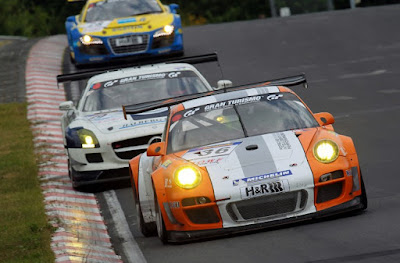Last year in the Nürburgring 24 Hour race, Porsche's 911 GT3 R Hybrid held the lead for more than eight hours before problems unrelated to the hybrid system saw it relegated through the field. The organizer of the event thought the performance potential of the vehicle was so auspicious that for this year it crippled the rear-mounted petrol engine's performance to just 448 bhp. So Porsche built a completely new vehicle to the same design around the new regulations, lowered the weight, upped the electrical drive to the front wheels to 200 bhp and set out to run the same lap times. Not only did it achieve the same lap times, it delivered even better fuel consumption, and four hours after the start of this year's race, it hit the lead once more ...
It's not surprising that the car cruised into the lead at this year's race around the "green hell", given the additional front wheel torque to haul the car out of corners and a quartet of Porsche works drivers - Joerg Bergmeister (Germany), Richard Lietz (Austria), Marco Holzer (Germany) and Patrick Long (USA) - but once again fate played a role and although the hybrid system functioned perfectly, unrelated problems crippled the challenge.
A broken flange in the differential sent it into the pits for repairs, which cost it an hour and around seven laps. Seven hours later, after the car was scything its way through the field once more, exactly the same problem struck again, necessitating a second unplanned pit stop. Though the time taken for repairs was only 40 minutes second time around, and only another five laps to make up, trying to claw back a total of 12 laps around the most demanding circuit in the world is no easy task.
The 911 GT3 R Hybrid rejoined the race in 105th place, and although lapping as fast and often faster than the front runners, it only managed to pull itself back to 35th place before yet another problem.
One of the many problems faced by faster cars in a 24 hour race is that of passing much slower cars frequently. On Sunday morning Patrick Long was lapping a slower car when he was nudged at high speed in the Flugplatz passage, spinning the car and necessitating another pit stop. After a quick check, where no damage was found, the car finished the race without further drama, finishing in 29th place outright.
Designed and built by Porsche R&D, the general layout of the 2011 911 GT3 R Hybrid remains quite similar to that of the 2010 model - a portal axle with two electric motors drives the front wheels while a detuned, 448 bhp four-liter flat-six drives the rear wheels.
One of the priorities for the development of the second generation 911 GT3 R Hybrid was the improvement of efficiency of the hybrid components, which resulted in a 20 percent reduction in overall weight of the hybrid system.
The output of both electric motors was increased from 60 to 75 kilowatts each, offering around 200 additional horsepower driving the front wheels.
The power can be added on the exit to corners via the throttle or manually accessed by the driver for overtaking.
Unlike most other hybrids, which store their regenerative brake sourced hybrid energy in electrical form in a battery or super-capacitor, this task in the Porsche is achieved by an electric flywheel accumulator. The flywheel rotor spins up to 40,000 rpm and stores energy mechanically as kinetic energy.
The flywheel generator is charged-up whenever the driver applies the brakes, with the two electric motors reversing their function on the front axle and acting themselves as generators.
Energy which is converted into heat (and hence wasted) in cars using traditional disc or drum brakes, is efficiently converted into mechanical energy.
The hybrid drive is not necessarily only used for extra power - it can also increase the efficiency of the 911 GT3 R Hybrid by saving fuel and making pit stops less frequent.
At first glance, the new GT3 R Hybrid is clearly distinguishable from the 2010 model. Thanks to the optimization of the hybrid system's high voltage components, the large louvers in front of the rear wheelarches were no longer necessary.
This reduces aerodynamic drag and also lowers fuel consumption. All in all, the weight of the vehicle decreased from 1,350 to 1,300 kilograms.
The cockpit of the 911 GT3 R Hybrid has also been completely revised. Most of the displays and controls have moved to the steering wheel. Drivers can operate the rest of the functions via backlit buttons now situated on the center console. Priority was placed on the ergonomics and the clear layout for drivers; always a priority but particularly significant when racing in darkness.
Via GizMag by Mike Hanlon
Luxury News / Golden Choice by Lux Creative International












